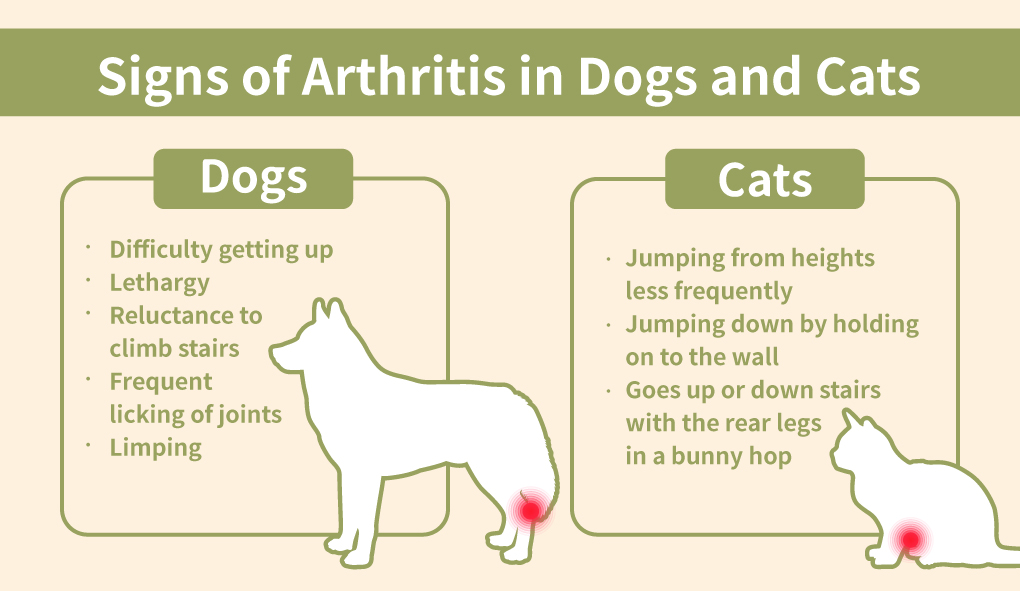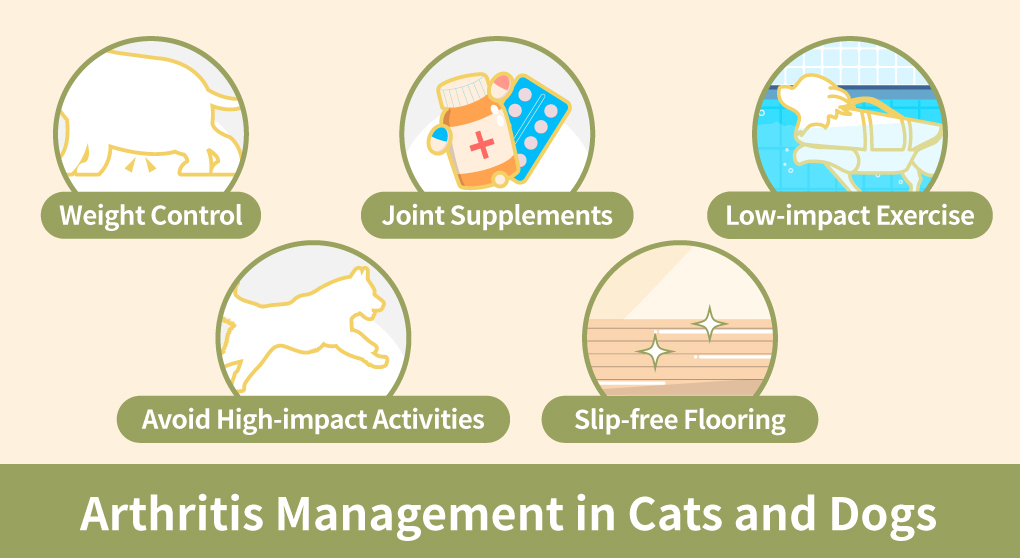Degenerative arthritis in dogs and cats: Management and Prevention
This article was written by Dr. Shang-Hsiu Chung, a veterinarian at Always Care Veterinary Hospital
What Can I Do About Arthritis in Pets? Preventing and Managing Osteoarthritis in Dogs and Cats
With the wear and tear of daily life on the joints, degenerative arthritis in cats and dogs is on the rise. Osteoarthritis in dogs and cats develop as they age. However, congenital abnormalities and weight problems can result in young pets with arthritis. So, parents are very concerned about pets with arthritis. We understand this concern. So, here are some tips to help you understand the common symptoms of osteoarthritis in dogs and cats. We also offer you some preventative measures and pet joint care to reduce the risk of osteoarthritis in dogs and cats.
Common Diseases in Senior Dogs and Cats
Dogs and cats between the ages of one to five are considered to be in their prime; over the age of five, they begin to reach middle age; and once they are over seven, they enter their senior years. Generally speaking, it is necessary to have regular joint care for dogs and cats over the age of five. One should have annual health checks as well and provide dogs with dog joint supplements as pets may suffer from various diseases. Common health issues in older animals include hearing or vision deterioration, joint problems, dementia, cancer, cardiovascular diseases, and others.What Is Osteoarthritis?
Osteoarthritis is one of the most common conditions of the joints in senior animals. U.S. statistics show that 80% of dogs over the age of 8 suffer from osteoarthritis, and 90% of cats over the age of 12 have the same problem.The shoulder, elbow, knee, and hip joints are commonly known problem centers. This is because of the degeneration of the tissue group composed of cartilage, synovial membrane and a joint cavity containing synovial fluid. This group of tissue is designed to cushion friction and pressure between the bones at a joint during movement. However, as we age, the cartilage that surrounds and protects the joint gradually deteriorates. The loss of this cushion causes the bones to rub against each other, causing pain and inflammation and ultimately resulting in osteoarthritis in dogs and cats.
Symptoms and Management of Osteoarthritis in Pets
The following behaviors may be observed in pets with arthritis:Dogs may have more difficulty getting up, lethargy, reluctance to climb stairs, difficulty posturing to urinate or defecate, frequent licking of joints, and in severe cases, even limping.
Cats often hide their pain, so it is harder for owners to detect it in the early stages of the disease. However, when the pain is more severe, you may find them less frequently jumping from heights or jumping down by holding on to the wall, or they may go up or down stairs with their rear legs in a bunny hop.
When the above signs of osteoarthritis are observed, it is recommended to have your dogs and cats evaluated by a veterinarian, who will make a diagnosis by performing a full physical exam and getting radiographs. Advanced analysis of the composition of the synovial fluid and arthroscopy can also be performed if needed.

Symptoms of Arthritis in Young Dogs and Cats
In addition to osteoarthritis, common in older dogs and cats, younger dogs may also be affected by arthritis. Hip dysplasia, abnormalities, or degeneration are relatively common in older dogs, especially bulldogs and pugs. Several factors lead to the development of hip dysplasia in dogs, including genetics, rapid weight gain caused by improper nutrition, or too much or too little exercise. A luxating patella is also a very common occurrence in dogs, and according to the literature, small breeds are 12 times more prone to the condition than large dogs. When the dog's patella (kneecap), which normally sits on the groove of the femur (thighbone), shifts out of alignment during movement, this is referred to as luxating patella. These previously mentioned joint issues in young dogs frequently increase their risk of developing osteoarthritis later in life.Prevention and Management of Joint Problems
When dealing with arthritis in your dogs and cats, consult your veterinarian first to discuss whether medical or surgical treatment is needed. In addition, daily care should focus on relieving joint pain and discomfort.- Weight management to maintain a healthy body shape and prevent obesity from putting additional strain on their joints.
- Low-impact, regular exercise to build muscles around joints and avoid joint stiffness.
- Limit or avoid high-impact activities like jumping up and down, walking up and down stairs, and climbing mountains, as these types of activities tend to increase the wear and tear of the cartilage.
- Avoid smooth tiles or wooden floors to prevent slipping and causing joint sprains.
- Choose the proper joint supplements for pets to provide nutrients for the production of synovial fluid, promote cartilage growth, and relieve joint discomfort by reducing inflammation and pain.
- Glucosamine, hyaluronic acid, and chondroitin increase synovial fluid.
- Glucosamine and undenatured type II collagen (UC-II) aid in the growth of joint cartilage.
- MSM, green-lipped mussel, and pineapple enzyme relieve joint pain.

The three interventions mentioned above, including medical treatment, joint burden reduction, and preventive care, save dogs and cats from experiencing joint pain!

Sarcopenia in Aging Dogs and Cats: Hidden Risks of Muscle and Joint Degeneration and Strategies for Care!What Is Sarcopenia? It’s More Than Just “Getting Thinner!
As dogs and cats grow older, many pet owners notice reduced activity levels and apparent weight loss. While these changes are often dismissed as normal signs of aging, they may actually indicate a more serious condition — sarcopenia. Sarcopenia is the gradual loss of muscle mass and strength caused by aging or chronic illness. Unlike general weight loss, which may involve fat or overall body mass, sarcopenia specifically targets muscle tissue. This means that even if a pet’s body weight appears stable, they could still be experiencing significant muscle loss.

The Complete Guide to Spaying and Neutering Your Pets: Surgery, Operative Care and Long-Term Health
Do cats and dogs really need to be spayed or neutered?” It’s one of the most frequent questions pet owners ask. Spay and neuter procedures go far beyond birth control—they are closely tied to better behavior, longer lifespans, and overall well-being. But surgery is only the first step. Lasting health depends on attentive post-operative care and the right nutritional support. Without it, pets may face higher risks of metabolic imbalances and chronic conditions. In this article, we’ll cover why and when spaying or neutering is truly necessary, how to prepare before and after surgery, a complete guide to operative care, and the common causes of slowed metabolism after the procedure—along with practical nutrition tips to help your furry companions stay healthy for years to come.








